Wondering how big a Calathea plant can grow? You’re not alone! This is one of the most commonly asked questions I get about prayer plants.
Generally, potted Calathea plants can grow up to 2 feet (60 cm) in height and produce leaves up to 2 feet wide. However, when planted outdoors, this plant can grow up to 4 feet tall. Factors such as plant care and species will affect how big a Calathea plant can grow.
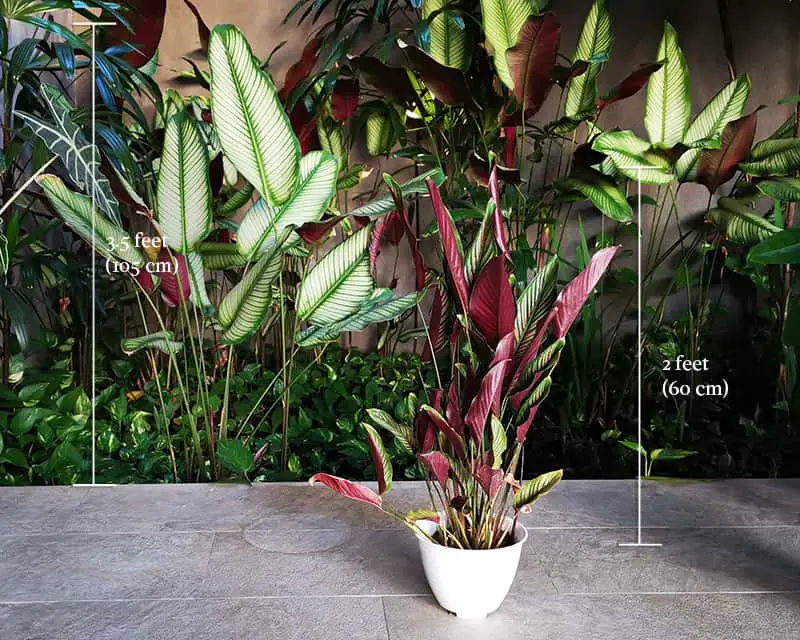
In this article, I will list out tips and tricks on how to encourage your Calathea plant to grow tall and bushy, as well as those steps to take if you want it to stay small.
Let’s get started!
Do Different Varieties of Calathea Have a Different Height?
I bet you’ve noticed that different varieties of Calathea can look very different from one another.
Calathea Warscewiczii and Rufibarba are known to be the taller varieties (up to 3 feet in height) and will have leaves that are bigger than those of other species.
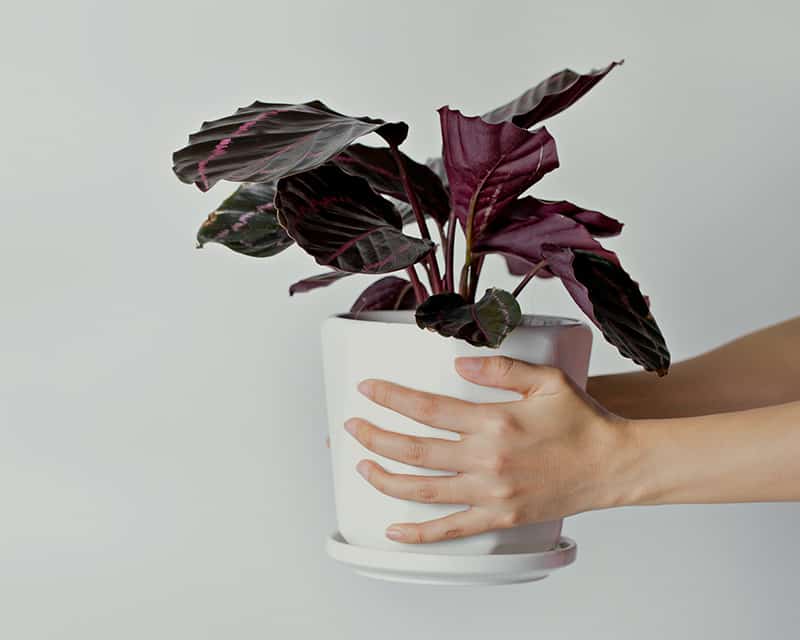
On the other hand, Calathea Roseopicta is smaller (up to 1.5 feet in height) and would be perfect for growing indoors.
While it’s true that the size of a Calathea plant can vary depending on the variety, its height potential also depends on how well you take care of it.
How Fast Will Calathea Grow into Mature Plant
Calathea plants grow slower compared to other common houseplants, such as the Golden Pothos or Spider Plant.
The growth of the indoor Calathea plant is classified as moderately fast, where it will reach maturity and its height potential (up to 2 feet) in one year and then stop growing.
How Often Does Calathea Grow New Leaves
The frequency of new leaf growth on your Calathea plant largely depends on several factors, including plant care and variety.
Generally, a new Calathea leaf will unfurl every month as long as you’re taking care of it properly.
If your Calathea plant has not grown any new leaves recently, you need to check out the following care guide.
Proper Calathea Care for Optimal Growth
Calathea plants will stop growing if it does not have enough water, light, and nutrients to turn them into energy through photosynthesis.
So, how can you ensure that your Calathea gets enough of these plant essentials?
Here are a few things to keep in mind:
Schedule Proper Watering
You need to water your Calathea at least once a week or when the top 2 inches of its soil is dry.
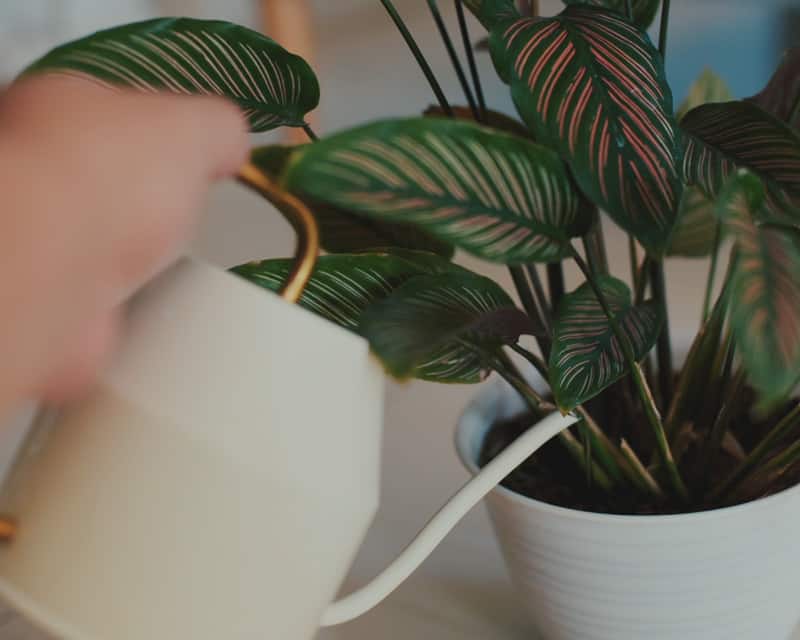
When under-watered, the plant does not have enough water to support its turgidity and produce energy for growth. Underwatering causes droopy, yellowing and curling leaves.
On the other hand, over-watering will put your Calathea at risk of fungal pathogens. This may lead to root rot which prevents the root from absorbing water and nutrients from the soil.
You’ll also want to use only filtered or distilled water for each watering. Tap water can lead to salt deposits around the root area, preventing the roots from absorbing nutrients and water.
Give Bright Indirect Light
Calathea requires medium light (10,000 lux; 1,000 foot-candles) for optimal growth.
To avoid sunburn, you should place your Calathea at least five feet away from a bright east or south-facing window. Use a sheer curtain to filter direct sunlight.
The prayer plant will go dormant if it does not receive enough light. You may need to supply artificial grow lights during winter or if your room is in a very low light condition.
Read my complete guide on Calathea Light Requirements
Feed with Fertilizer
Calathea plants need three primary nutrients to grow: Nitrogen (N), Phosphorus (P) and Potassium (K).
Nitrogen boosts the production of chlorophyll and leaf growth. Phosphorous encourages the formation of new healthy roots and flowers (yups, some Calathea varieties have flowers). While Potassium helps strengthen the stems and make them grow taller.
In addition, Calathea requires small amounts of micronutrients such as boron (B), zinc (Zn), manganese (Mn), iron (Fe), copper (Cu), molybdenum (Mo), chlorine (Cl) to thrive.
Given these considerations, you need to feed your Calathea with a balanced NPK fertilizer once a month during Spring and Summer. Dilute half the recommended dose before using it to water your Calathea.
When it’s wintertime, don’t feed your prayer plant because they are dormant, and feeding them will only accumulate salt around the roots.
Repot into Larger Pot
Sometimes, you know that you have given your Calatheas proper care, but it still does not grow. Have you considered repotting it into a bigger pot?
Calathea plants in small pots are often rootbound. When the roots take up all the space, there is not enough room for the soil to hold water. This makes it hard for the plant to grow.
You should consider repotting Calathea plants once a year into a pot that is 2 to 4 inches larger in diameter. Make sure to provide the plant with fresh new soil that is aerated and well-draining.
Here’s a tip: Consider using heavier pots such as terracotta to hold your taller Calathea plants. I’ve noticed that my prayer plants tend to fall over because of the wind in plastic pots.
Clean the Leaves
Although time-consuming, cleaning your Calathea plants’ leaves regularly will provide a better chance for them to grow larger.
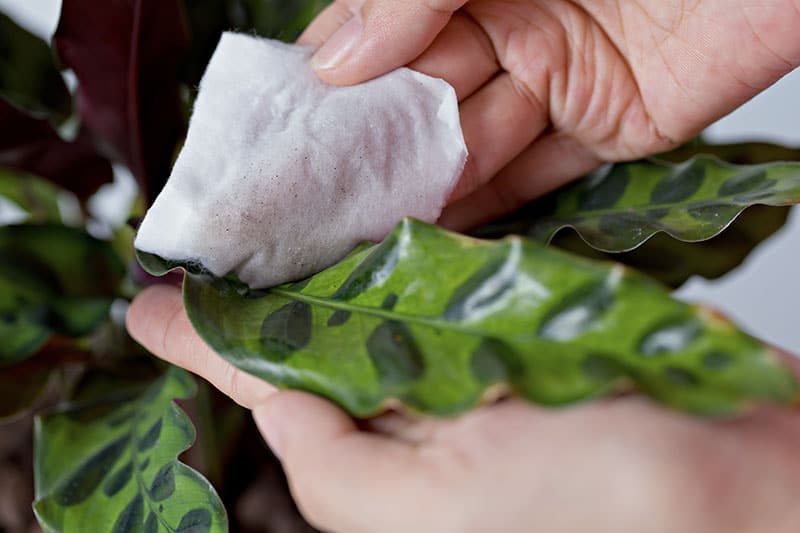
Dirt and dust can clog up the leaf’s stomata, slowing down its photosynthesis process. Wipe leaves with a lightly damp microfiber cloth every week to remove them.
Additionally, while cleaning the leaves, you may find and eliminate pest presence early rather than having them become a problem.
How to Keep Calathea Plants Small
When growing a Calathea, you might want to keep it small for aesthetics.
Here are a few strategies you might want to consider:
Pruning the Roots
Calathea plants will grow only as large as the root system they are given. You can keep them small by regularly trimming the roots in Spring once the growth starts.
First, you need to take your Calathea out of the pot and loosen its outer roots from the soil mass.
Then, you need to trim back the loosened roots to within 1 inch of each plant’s main root ball. Finally, repot the plant in its original pot.
Be cautious that trimming the root will cause the plant to be stressed.
Propagate your Calathea
A better way of maintaining the size of your Calathea is by propagating the plants by dividing.
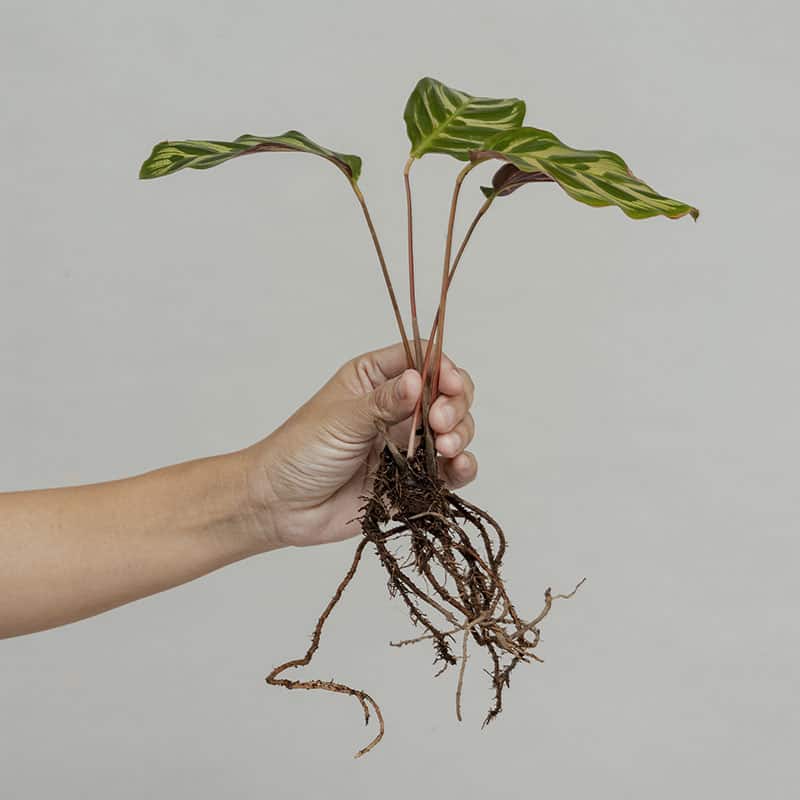
Take out the Calathea plant from its pot and divide the root system using sharp, clean shears. Ensure that each cutting has a root system attached to it.
Finally, repot your cuttings into pots of a similar size to their original pot.
Using Dilute Alcohol
Frankly, I haven’t done this before, but I have read that using diluted alcohol will stunt the growth of a plant without killing it.
5% solution of ethanol, or grain alcohol, can be used to stop the growth of your Calathea.
On the other hand, plants given more than 10% ethanol will become stressed and die.
You should never pour beer and wine on plants because the sugar content encourages bacteria and fungi growth, damaging or killing the plant.
